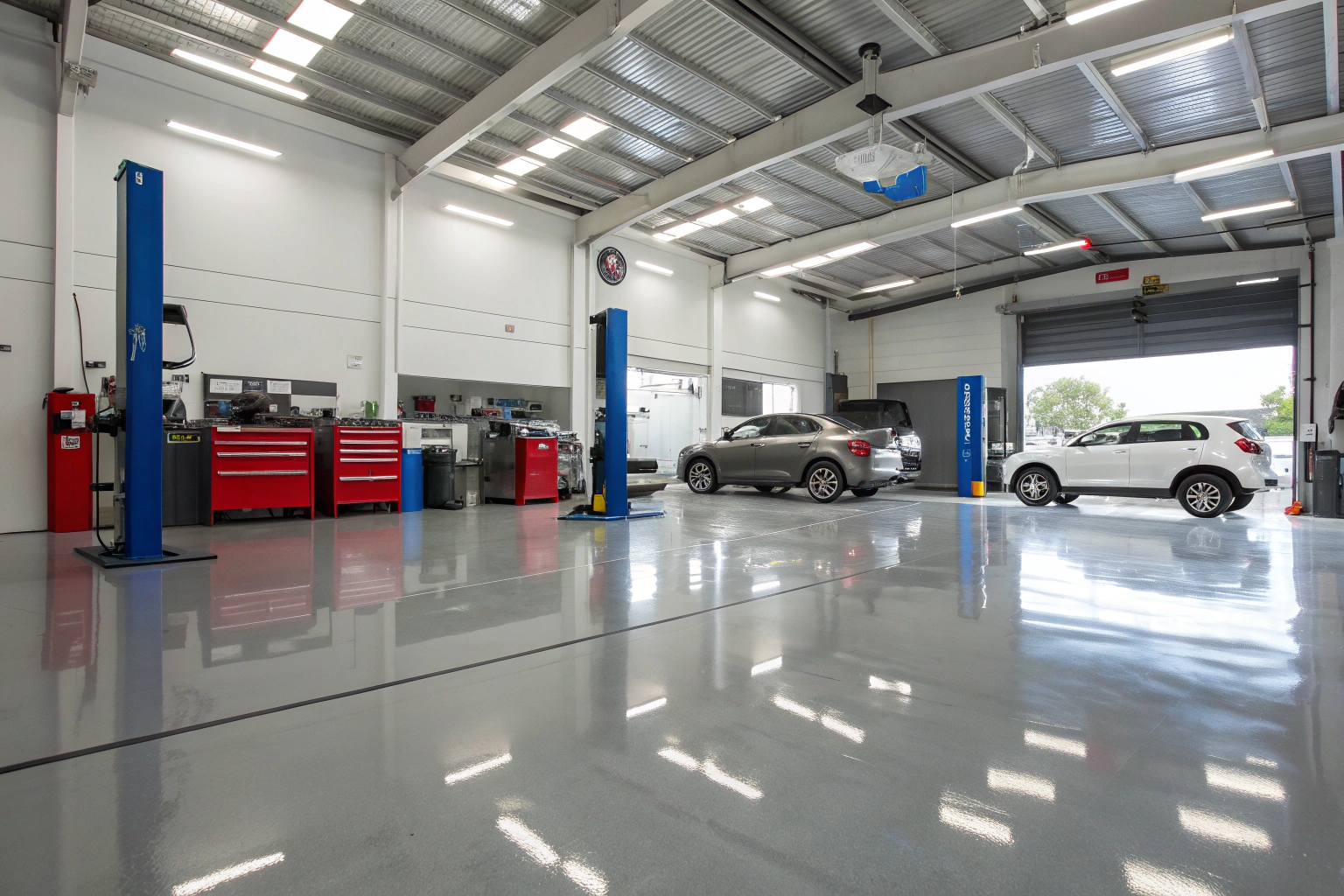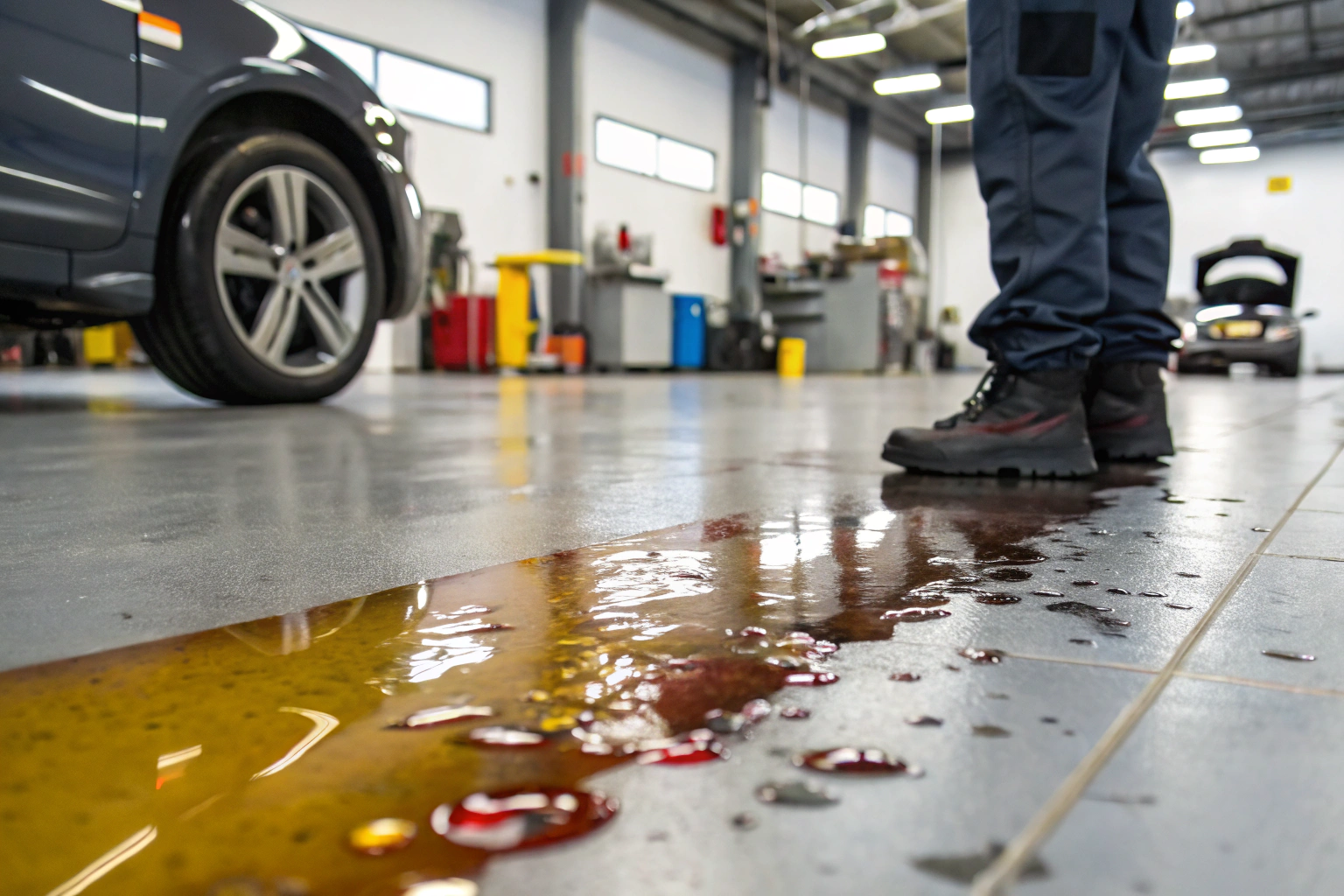
Aesthetic Appeal That Impresses
First impressions influence customer decisions more than most workshop owners realise. Clean, modern flooring signals professionalism and attention to detail that builds confidence in your service quality. The high-gloss finish reflects lighting throughout your facility, creating a brighter workspace while showcasing your commitment to maintaining a premium operation that customers trust with their vehicles.

Investment Value for Your Business
Automotive shop epoxy flooring delivers measurable returns beyond appearance through improved operations and reduced costs. The investment pays back through multiple channels that directly impact your bottom line and business growth.
Business value benefits:
- Operational efficiency – Reduced cleaning time means more billable hours servicing vehicles instead of fighting stains
- Customer retention – Professional appearance builds confidence and differentiates you from competitors on stained concrete
- Employee satisfaction – A Clean working environment improves morale and helps attract skilled technicians.
- Property value – Quality flooring increases facility value for owned properties or demonstrates commitment for leased spaces

Installation Process for Automotive Facilities
Professional epoxy installation in operating workshops requires careful planning to minimise business disruption while delivering quality results that last for decades.
Minimising Business Downtime
Most workshops can’t close completely for flooring work. We phase installations across different bays or zones, allowing vehicle service to continue in unaffected areas. Weekend and after-hours scheduling options maintain normal weekday operations while progressing steadily toward completion.
Surface Preparation and Equipment Management
Proper epoxy adhesion depends on thorough concrete preparation through diamond grinding to remove contamination and create a mechanical profile. We work around fixed equipment like hydraulic lifts and compressors, integrating flooring with mounting points. Portable tool cabinets are relocated temporarily to completed zones.
Curing and Return to Service
Automotive epoxy requires longer cure times than residential systems to achieve full chemical resistance before aggressive fluid exposure. Light foot traffic becomes possible within 24 hours, but waiting 5-7 days before full chemical exposure ensures optimal performance and longevity that your workshop demands.

Automotive-Grade Flooring Performance
Automotive environments demand flooring that survives constant chemical exposure, heavy impacts, and vehicle traffic that destroys standard concrete within months. Professional epoxy creates an impermeable barrier where spills sit on the surface until cleanup instead of penetrating and staining permanently.
Chemical resistance that works:
- Motor oil and transmission fluid – Complete protection against petroleum-based fluids
- Brake fluid and coolants – Withstands aggressive hydraulic and antifreeze chemicals
- Fuel and solvents – Resists gasoline, diesel, and degreaser exposure
- Battery acid – Protects against corrosive electrolyte spills
The non-porous surface prevents absorption, eliminating odours and ongoing floor degradation.
Safety and Compliance Benefits
Automotive workshop flooring directly impacts workplace safety and regulatory compliance across multiple areas. Proper epoxy systems help meet legal requirements while protecting your team from accidents and injuries. The sealed surface prevents fluid penetration that creates environmental liability, while slip-resistant textures maintain traction even when contaminated. Better lighting reflection improves visibility for detailed work, and easy spill cleanup means hazards get addressed immediately rather than lingering.
Key compliance advantages:
- Slip resistance – Maintains traction even with oil contamination, reducing workplace accidents
- Environmental protection – Sealed surface prevents automotive fluid penetration and groundwater contamination
- Insurance standards – Satisfies commercial policy requirements, potentially reducing premiums
- Spill containment – Non-porous barrier helps meet EPA and council environmental regulations
Maintenance for Long-Term Performance
Proper maintenance keeps your epoxy flooring performing like new for decades with minimal effort compared to concrete’s constant cleaning demands.
Simple maintenance protocols:
- Daily cleaning – Regular sweeping removes abrasive particles; spills are wiped up in seconds without penetrating
- Periodic deep cleaning – Monthly degreasing with standard equipment maintains a fresh appearance without high-pressure washing
- Prompt spill response – Clean brake fluid and aggressive chemicals within reasonable timeframes for optimal appearance
- Annual inspections – Identify minor wear or damage early; small chips touch up without refinishing the entire floor
- Proactive care – Simple maintenance extends flooring life while maintaining a consistent professional appearance across your workshop
Frequently Asked Questions
Yes, we design epoxy systems specifically to integrate with hydraulic lifts and vehicle hoists. The flooring reinforces around mounting points and anchor bolts, and we work carefully during installation to avoid compromising lift stability. Proper installation ensures both equipment functionality and complete floor coverage without gaps or weak points.
Automotive-grade epoxy incorporates anti-slip aggregates that maintain traction even when contaminated with oils and fluids. Unlike smooth residential epoxy, workshop flooring uses specialized textures designed specifically for environments where chemical spills occur regularly. The slip resistance meets workplace safety standards for automotive facilities.
Automotive epoxy uses specialised chemical formulations with enhanced resistance to petroleum products, brake fluids, solvents, and aggressive automotive chemicals. It’s also thicker and more impact-resistant than residential systems. Standard epoxy may look similar initially, but fails quickly under automotive workshop conditions, while proper automotive-grade systems maintain performance for decades.
Yes, but proper surface preparation removes all contamination first. We diamond grind the concrete to eliminate oil penetration, open the pore structure, and create the mechanical profile needed for adhesion. Heavily contaminated concrete may require additional preparation steps, but we can successfully coat almost any automotive workshop floor regardless of current condition.

